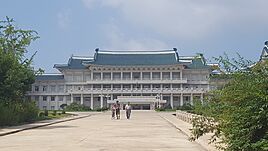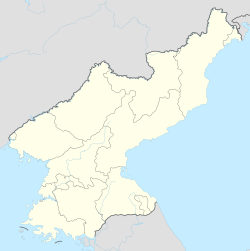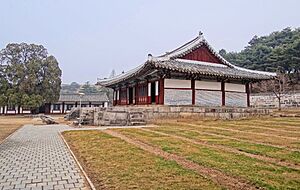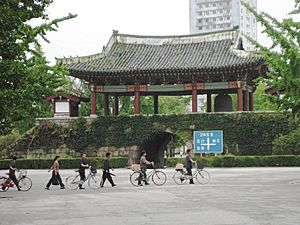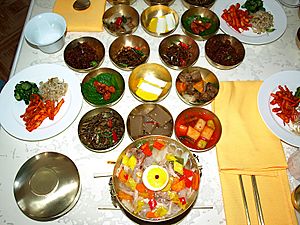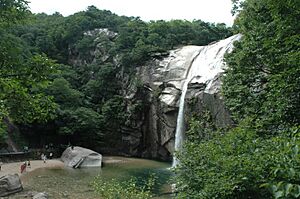Kaesong facts for kids
Quick facts for kids
Kaesong
개성시
|
|
|---|---|
|
Special city
|
|
| Korean transcription(s) | |
| • Chosŏn'gŭl | 개성특별시 |
| • Hanja | 開城特別市 |
| • McCune–Reischauer | Kaesŏng-T'ŭkpyŏlsi |
| • Revised Romanization | Gaeseong-Teukpyeol-si |
|
Clockwise from top: Koryo Songgyungwan University, Mausoleum of King Kongmin, street in Kaesong, skyline of Kaesong Industrial Region and downtown Kaesong, Sungyang Academy, fall foliage in Kaesong
|
|
| Nickname(s):
"City of Pines" (송도; 松都; Songdo)
|
|
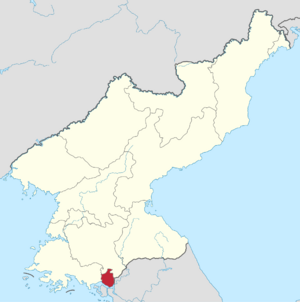
Kaesong location within North Korea
|
|
| Country | North Korea |
| Province | Kaesong |
| Settled | c. 700 |
| Administrative divisions | 24 dong, 3 ri |
| Area | |
| • Total | 179.26 km2 (69.21 sq mi) |
| Population
(2009)
|
|
| • Total | 192,578 |
| • Density | 1,074.29/km2 (2,782.41/sq mi) |
| • Dialect | Gyeonggi |
| Time zone | UTC+9 (Pyongyang Time) |
| Other information | Split from Gyeonggi in 1951; joined North Hwanghae in 2003. Left North Hwanghae and became special city in 2019. |
Kaesong is a special city in the southern part of North Korea. It was once the capital of Korea during the Goryeo dynasty. The city is close to the border with South Korea. It is known for its historical sites and its role in trade.
Kaesong was called Songdo when it was the capital of Goryeo. It became a busy trading center, especially for Korean ginseng. Today, Kaesong is a hub for light industry in North Korea.
During the Japanese rule (1910-1945), the city was known as "Kaijō." After World War II, it was part of South Korea for a short time. During the Korean War, Kaesong came under North Korean control. Because it is so close to the border, Kaesong has hosted economic exchanges between North and South Korea. This includes the Kaesong Industrial Region, a special factory area.
As of 2009, about 192,578 people lived in Kaesong.
| Top - 0-9 A B C D E F G H I J K L M N O P Q R S T U V W X Y Z |
Kaesong's Long History
Kaesong has a very old history, with signs of people living there since the Neolithic Age. This was a time when people first started using stone tools and pottery.
Over many centuries, Kaesong was part of different kingdoms and its name changed.
- It was called Busogap during the Goguryeo kingdom.
- Later, it became part of Silla in 555 AD. Its name then changed to Song'ak-gun.
- Around 694 AD, it was known as "Song'ak."
Kaesong as the Goryeo Capital
In the late 800s, the Silla kingdom began to weaken. A new period of different leaders fighting for power started. In 898, Kaesong was taken by Gung Ye, who founded the short-lived state of Taebong.
Then, in 919, a new kingdom called Goryeo was formed by Wang Geon. He became Taejo of Goryeo, the first king. Taejo made Kaesong the capital of Goryeo. The city was renamed "Gaeju." In 960, it was called Gaegyeong. Later, in 995, it became "Gaesong-bu."
In 1010, much of the city was burned during a war. In 1018, Kaesong was reorganized.
In the late 1100s, there was some unrest. A slave named Manjeok led a group of slaves in a revolt outside Kaesong in 1198. However, this uprising was stopped.
In 1392, Yi Song-gye took over from Goryeo and started the Joseon dynasty. He moved the capital from Kaesong to Hanyang, which is now Seoul, in 1394.
Kaesong in the 20th Century

Kaesong was part of Gyeonggi Province until the Korean War. After World War II, Korea was divided at the 38th parallel. Kaesong was initially on the South Korean side.
However, during the first days of the Korean War, the Korean People's Army (North Korea) captured Kaesong. United Nations (UN) forces briefly took the city back in October 1950. But they had to leave it in December 1950 when Chinese forces joined the war. Kaesong remained under North Korean control for the rest of the war.
Peace talks to end the war began in Kaesong on July 10, 1951. Later, they moved to Panmunjom. The Korean Armistice Agreement, signed on July 27, 1953, officially gave Kaesong to North Korea. It was the only city to change control from South to North Korea because of the war.
After the war, Kaesong was made a "Directly Governed City" in 1957. This meant it was managed directly by the central government.
Kaesong in the 21st Century
In 2002, a part of Kaesong was used to create the Kaesong Industrial Region. This was a special area for factories where North and South Koreans worked together.
In 2003, the rest of Kaesong joined North Hwanghae Province. However, in October 2019, Kaesong became a "Special City" again. This means it has a special status within North Korea. The city is very close to the Demilitarized Zone (DMZ), which separates North and South Korea.
Kaesong's Geography and Climate
Kaesong is the southernmost city in North Korea. It is surrounded by mountains like Songak (489 meters high) and Pongmyong. The city center is built around the smaller Mt. Janam (103 meters).
The Imjin River flows along the city's northeastern border. The Ryesong River runs along the western border. These rivers, along with smaller streams, flow into the Han River. The land in the southwest has wide, flat plains.
The ground in Kaesong has different types of rock from ancient times. There are also natural resources underground, such as gold, zinc, copper, and limestone. The soil is mostly brown forest soil, but near the rivers, it's rich alluvial soil.
Kaesong's Weather
Kaesong has a climate with cold, dry winters and hot, wet summers. The average temperature for the year is about 10 °C (50 °F).
- January is the coldest month, averaging about -5.9 °C (21.4 °F).
- August is the hottest month, averaging about 24.7 °C (76.5 °F).
Kaesong gets a lot of rain, usually between 1,300 and 1,400 millimeters (51 to 55 inches) per year. The city has a long frost-free period, which is good for farming. About 55% of Kaesong is covered in forests, mostly pine trees. Many different animals live here, including 40 types of mammals and 250 types of birds.
Administrative Divisions
Kaesong is divided into 24 administrative districts called Dong. It also has three villages, known as ri.
Some of the important Dong (districts) include:
- Koryŏ-dong: Where the Anhwasa temple is located.
- Manwŏl-tong: Named after the historic Manwoldae palace.
- Nammun-dong: Named after the South Gate. The famous Bell of Yonbok Temple is here.
- Pugan-dong: Home to the Kaesong Students' and Children's Palace.
- Sŏnjuk-tong: Named after the famous Sonjuk Bridge.
After Kaesong became a Special City again, Changpung County, Kaepung-guyok, and Panmun-guyok returned to being part of Kaesong.
Culture and Landmarks
Kaesong is home to many historical sites that are part of a World Heritage Site called "Historic Monuments and Sites in Kaesong."
Important places to visit include:
- Koryo Songgyungwan University: A university focused on light industry.
- Koryo Museum: Located in the old Confucian academy. It displays many valuable Goryeo arts and cultural items.
- Kaesong Namdaemun: A historic gate.
- Sonjuk Bridge: A famous old bridge.
- Manwoldae Palace: The ruins of the Goryeo-era palace.
- Kaesong Chomsongdae: An ancient observatory.
Many tombs of Goryeo kings are in the area. The heavily rebuilt Tomb of King Wanggon, who founded the Goryeo dynasty, is west of the city. Other royal tombs include those of kings Hyejong of Goryeo, Gyeongjong of Goryeo, and Gongmin of Goryeo.
Kaesong also has North Korea's only two royal tombs from the Joseon dynasty. These are the Hurung Royal Tomb and the Cherung Royal Tomb. They are not part of the Joseon Dynasty World Heritage Site because they are in North Korea.
Kaesong Cuisine
Since Kaesong was the capital of Goryeo for almost 500 years, its food culture became very rich. Kaesong cuisine is known for its fancy style.
Some famous Kaesong dishes include:
- Bossam kimchi: Kimchi wrapped in a special way.
- Pyeonsu: Square-shaped summer dumplings.
- Sinseollo: A royal casserole.
- Seolleongtang: Ox bone soup.
- Joraengi tteokguk: Rice cake soup.
- Umegi: A sweet rice cake covered with syrup, also called Kaesong juak. This is a special holiday food.
Kaesong's Economy
Kaesong has good natural conditions for farming. It has 18 reservoirs and many pumping stations to help with irrigation. About 27% of Kaesong's land is used for farming.
The main crops grown are:
Kaepung and Panmun are the main areas for growing rice. Farmers also grow vegetables and fruits like peaches, apples, and persimmons. Peach is a special fruit from Kaesong, especially the white peach. Livestock farming and sericulture (raising silkworms) are also important. The counties of Kaepung-gun and Panmun-gun are famous for growing high-quality Korean ginseng.
Kaesong is a major center for light industry in North Korea. The city has factories that make:
- Jewelry
- Ginseng products
- Embroidery
- Textiles (cloth)
- Grocery items
- Food products like jang (soybean paste), oil, and canned foods.
- Alcoholic drinks and soft drinks.
- Resin, timber, handicrafts, pottery, shoes, and musical instruments.
The Central Bank of North Korea has its headquarters in Kaesong.
North and South Korea used to run the Kaesong Industrial Region together. This industrial park opened around 2005. It employed over 53,400 North Koreans in more than 120 South Korean factories. In 2012, it produced about $470 million worth of goods. The park was temporarily closed in 2013 and again in 2016 due to political tensions.
Tourism in Kaesong
Kaesong is a popular place for tourists visiting North Korea. Many historical sites from the Goryeo period are here.
Some popular tourist spots include:
- Kaesong Namdaemun gate
- Songgyungwan Confucian Academy (now the Koryo Museum)
- Sonjuk Bridge and Pyochung Pavilion
- Kwandok Pavilion
- Ruins of Manwoldae Palace
- Anhwa Temple
- Kaesong Chomsongdae observatory
West of the city are the tombs of kings Kongmin and Wanggon. About 24 km north of Kaesong is Taehungsan Fortress. This old fortress was built to protect Pyongyang. It contains the Kwanum and Taehung Temples.
The beautiful Pakyon Falls are also in the area. There is also a large, recently found Goryeo-era Buddha statue carved into a stone on Mt. Chonma. Most tourists stay at the traditional Kaesong Folk Hotel, which is made up of 19 old hanok (Korean traditional houses).
Education in Kaesong
Sungkyunkwan, located north of Seonjukgyo bridge, is a very old and important educational place in Kaesong. It was founded in 992 during the Goryeo dynasty. It was originally called Gukjagam and was a key place for Korean Confucianism. Its name changed to Seonggyungwan later. Famous Confucian scholars like Yi Saek and Chŏng Mong-ju taught there.
The first modern school in Kaesong was Hanyeong Seowon, or Anglo-Korean School. It was started in 1906. This school later became Songdo High School. During the Korean War, many schools, including Songdo High School, moved to South Korea.
By 1950, Kaesong had several public and private high schools, and eight public elementary schools.
As of 2002, Kaesong had:
- 80 public elementary schools
- 60 middle-high schools
- 3 colleges
- 3 universities, including Songdo University of Politics and Kaesong University of Education.
Transportation
Kaesong is connected to Pyongyang and other cities by both trains and roads. The main train station in the city is Kaesong Station, which is on the Pyongbu Line.
Sister Cities
Kaesong has a sister city relationship with:
 Cusco, Peru (since 1990)
Cusco, Peru (since 1990)
Famous People from Kaesong
Many notable people were born in Kaesong, including:
- Uicheon (1055–1191): He founded the Cheontae Buddhist sect.
- Ch'oe Ch'ung-hŏn (1149–1219): A military leader during the Goryeo period.
- Hwang Hui (1363–1452): A prime minister during the Joseon dynasty.
- Hwang Jin-i (1515–1550): A famous Kisaeng (female entertainer) and poet.
- Youn Yuh-jung (1947–): A South Korean actress who won an Academy Award.
See also
 In Spanish: Kaesong para niños
In Spanish: Kaesong para niños


